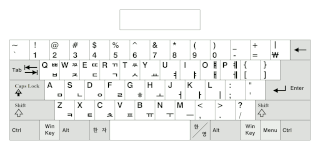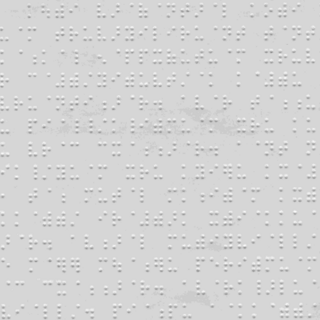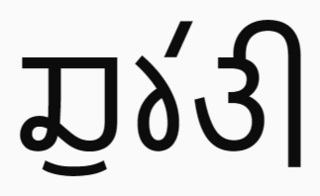The Rahar (or Raher, Rad, Rahad, Rar, Radh, Riar) is a clan (gotra) of Jats found in the Indian states of Rajasthan, Haryana, Punjab, and Madhya Pradesh and in Sindh province of Pakistan. [1]
The Rahar (or Raher, Rad, Rahad, Rar, Radh, Riar) is a clan (gotra) of Jats found in the Indian states of Rajasthan, Haryana, Punjab, and Madhya Pradesh and in Sindh province of Pakistan. [1]

The Brahmic scripts, also known as Indic scripts, are a family of abugida writing systems. They are used throughout the Indian subcontinent, Southeast Asia and parts of East Asia. They are descended from the Brahmi script of ancient India and are used by various languages in several language families in South, East and Southeast Asia: Indo-Aryan, Dravidian, Tibeto-Burman, Mongolic, Austroasiatic, Austronesian, and Tai. They were also the source of the dictionary order (gojūon) of Japanese kana.
Devanagari is an Indic script used for many Indo-Aryan languages of North India and Nepal, including Hindi, Marathi and Nepali, which was the script used to write Classical Sanskrit. There are several somewhat similar methods of transliteration from Devanagari to the Roman script, including the influential and lossless IAST notation. Romanised Devanagari is also called Romanagari.

An input method is an operating system component or program that enables users to generate characters not natively available on their input devices by using sequences of characters that are available to them. Using an input method is usually necessary for languages that have more graphemes than there are keys on the keyboard.
Indian Standard Code for Information Interchange (ISCII) is a coding scheme for representing various writing systems of India. It encodes the main Indic scripts and a Roman transliteration. The supported scripts are: Bengali–Assamese, Devanagari, Gujarati, Gurmukhi, Kannada, Malayalam, Oriya, Tamil, and Telugu. ISCII does not encode the writing systems of India that are based on Persian, but its writing system switching codes nonetheless provide for Kashmiri, Sindhi, Urdu, Persian, Pashto and Arabic. The Persian-based writing systems were subsequently encoded in the PASCII encoding.
The International Alphabet of Sanskrit Transliteration (IAST) is a transliteration scheme that allows the lossless romanisation of Indic scripts as employed by Sanskrit and related Indic languages. It is based on a scheme that emerged during the 19th century from suggestions by Charles Trevelyan, William Jones, Monier Monier-Williams and other scholars, and formalised by the Transliteration Committee of the Geneva Oriental Congress, in September 1894. IAST makes it possible for the reader to read the Indic text unambiguously, exactly as if it were in the original Indic script. It is this faithfulness to the original scripts that accounts for its continuing popularity amongst scholars.
Uniscribe is the Microsoft Windows set of services for rendering Unicode-encoded text, supporting complex text layout. It is implemented in the dynamic link library USP10.DLL. Uniscribe was released with Windows 2000 and Internet Explorer 5.0. In addition, the Windows CE platform has supported Uniscribe since version 5.0.

The zero-width joiner is a non-printing character used in the computerized typesetting of writing systems in which the shape or positioning of a grapheme depends on its relation to other graphemes, such as the Arabic script or any Indic script. Sometimes the Roman script is to be counted as complex, e.g. when using a Fraktur typeface. When placed between two characters that would otherwise not be connected, a ZWJ causes them to be printed in their connected forms.
Vaishnava Jana To is a Hindu bhajan, written in the 15th century by the poet Narsinh Mehta in the Gujarati language. The poem speaks about the traits and the ideals of a Vaishnava jana.
Indian calligraphy is the Indian tradition of calligraphy. The art form has served multiple purposes since its inception in the second century BCE, including the duplication of religious texts and as a form of basic communication.
Indic Computing means "computing in Indic", i.e., Indian Scripts and Languages. It involves developing software in Indic Scripts/languages, Input methods, Localization of computer applications, web development, Database Management, Spell checkers, Speech to Text and Text to Speech applications and OCR in Indian languages.
Google IME, also known as Google Input Tools, is a set of input method editors by Google for 22 languages, including Amharic, Arabic, Bengali, Chinese, Greek, Gujarati, Hindi, Japanese, Kannada, Malayalam, Marathi, Nepali, Persian, Punjabi, Russian, Sanskrit, Serbian, Tamil, Telugu, Tigrinya, and Urdu. It is a virtual keyboard that allows users to type in their local language text directly in any application without the hassle of copying and pasting.

Sirmauri is a Western Pahari language spoken in the Sirmaur district in the northern Indian state of Himachal Pradesh. Its two main varieties are Dharthi and Giripari.

Tamil Braille is the smallest of the Bharati braille alphabets.
Chinali is an unclassified, and critically endangered language of India spoken by about 220 people. Many speakers are well educated. Speakers are distributed throughout Lahul Valley. It is written in the Devanagari script. It's possible that Chinali is also closely related to Sanskrit.
Gha is the fourth consonant of Indic abugidas. In modern Indic scripts, gha is derived from the early "Ashoka" Brahmi letter , which is probably derived from the Aramaic ("H/X") after having gone through the Gupta letter .
The CS Indic character set, or the Classical Sanskrit Indic Character Set, is used by LaTeX represent text used in the Romanization of Sanskrit. It is used in fonts, and is based on Code Page 437. Extended versions are the CSX Indic character set and the CSX+ Indic character set.
The CSX Indic character set, or the Classical Sanskrit eXtended Indic Character Set, is used by LaTeX represent text used in the Romanization of Sanskrit. It has no association with American railroad company CSX Transportation. It is an extension of the CS Indic character set, and is based on Code Page 437. An extended version is the CSX+ Indic character set. Michael Everson made a font in this character set for the Macintosh.
The CSX+ Indic character set, or the Classical Sanskrit eXtended Plus Indic Character Set, is used by LaTeX to represent text used in the Romanization of Sanskrit. It is an extension of the CSX Indic character set, which in turn is an extension of the CS Indic character set, and is based on Code Page 437. It fixes an issue with Windows programs, by moving á from code point 160 (0xA0), to code point 158 (0x9E).

Churahi is a Western Pahari language of Himachal Pradesh, India. It is spoken in the Chaurah and Saluni tehsils of Chamba district, and is considered endangered.